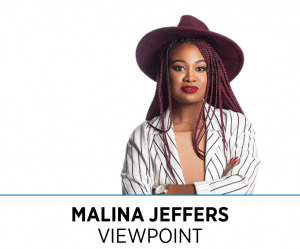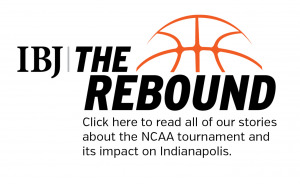Subscriber Benefit
As a subscriber you can listen to articles at work, in the car, or while you work out. Subscribe Now Right now, a trip downtown in Indianapolis would offer you an incredibly special type of energy. You’d feel a sense of excitement, some expectation. You’d feel the intentionality behind what went into everything that is March Madness in Indy, and maybe most of all, you’d feel a sense of elevated culture.
Right now, a trip downtown in Indianapolis would offer you an incredibly special type of energy. You’d feel a sense of excitement, some expectation. You’d feel the intentionality behind what went into everything that is March Madness in Indy, and maybe most of all, you’d feel a sense of elevated culture.
You’d notice new vinyl wraps on downtown buildings featuring artwork by local artists. You’d see art installations and retail pop-up shops in spaces you’d never realize were previously vacant. You’d turn the corner and hear live music or maybe a meditative sound bath happening in a public gathering space. You’d find culture.
We, Indy, led with culture. So why do we think that happened and why, at a moment after everything that was 2020, did we settle on arts and culture as the flag we’d wave for such a historic series of games in our city center? Well maybe it was already top of mind. In 2020, to get through the physical and mental trauma of our collective experience, we turned to the arts.
We turned live music into virtual in-home concerts to support our venues and artists. We painted on boarded windows in our downtown square. We lettered Black Lives Matter on the street in protest.
 Like the civil rights movement of the ‘60s and how that generation turned to art via music, in this moment we turned to the visual arts. And maybe we learned more from that than we realized. Or maybe we enjoyed it more than we realize. That is one gift we received from the pandemic: the spotlight on our need for and turning to arts and culture in a moment of crisis.
Like the civil rights movement of the ‘60s and how that generation turned to art via music, in this moment we turned to the visual arts. And maybe we learned more from that than we realized. Or maybe we enjoyed it more than we realize. That is one gift we received from the pandemic: the spotlight on our need for and turning to arts and culture in a moment of crisis.
Beyond it having been our crutch in the year past, there are three reasons that I believe led us to leveraging arts and culture so strongly during March Madness. It’s likely that only one of them was a conscious strategy. And bear with me, readers. I am not pushing propaganda but merely learning along with you the incredible power and resilience of culture in America.
We leveraged racial tension and verbal commitments toward equity.
Arts and culture feel like an easy pathway to support people of color and contribute to our city’s newfound commitment to racial equity. Although we don’t yet know how to say – or don’t know if it’s ok to say – there is a unique relationship between arts and culture and people of color, and specifically, Black people.
In February of 2020, Google released a study that said Black people are the most searched and have dominated American culture for at least the last 15 years.
While making up only 13% of the US population, Black people are at the top of the influential sphere. And this shouldn’t be a complete shocker because we all know the stories of Pat Boone to Elvis to Jack Daniels, all wealthy White-owned brands who got their content from Black people who remained hidden and unpaid. Black people have contributed more to American culture than they’ve gotten back.
So, yes, there’s a direct line of or common denominator within the arts and culture scene and Black people – especially in Indianapolis; hello, Indiana Avenue. What an outstanding – and convenient – way to lift two groups, two industries if I may, at the same time and in the form of celebration. Absolutely this was an equity play and it was a good one.
The Swish Indy series included just over 50% of artists of color. There was finally intentional effort to include many more people of color and while long overdue, it was refreshing and energizing. My hope is that these artists remain “in the light” to organizing bodies and the traction to support them takes off into real flight.
More than any other industry, culture brings people together.
The second reason we went all in on arts and culture is because there is no other professional sector that brings people together more. Think of the times you’ve felt most connected to others. To humanity. To yourself. Often, there was a cultural element to that experience.
When we want to engage with our friends and family, we dine and drink together. When we celebrate each other, it comes with a happy birthday song. When we’re out running or walking, it’s usually to, from or near a cultural destination.
As much as we love and value and economically support our sports activities, we don’t realize that so much of what we enjoy about the experience is culture.
Why do you think the NFL hired Roc Nation as creative director for the Superbowl? Why did Indy’s Civic Leadership Alliance hire GANGGANG as creative director for all March Madness live performances? Because culture brings people together most, provides the beacon of hope we’re all desperate for and because it just feels so damn good.
More than that, it proves our tendency toward and need for more private and public partnerships. We talk about it often but how can we include more cultural organizations in these collaborations? How do we directly include and engage individual artists on more consistent and gainful basis?
GangGang’s co-founder, Alan Bacon, comes from a family of Indianapolis musicians that had great careers in this city. His uncle recently sent a text saying “There has never been this level of leadership, reciprocal partnerships, and active participation by minorities for NCAA’s March Madness and certainly never in Indy. If you can have this level of success during a pandemic, imagine what success we can achieve on future endeavors when it’s over.”
The next big thing is a million different (cultural) things.
The third reason for the hyper and incredible focus on arts and culture to enliven The Big Dance is because it’s a shot to tell ourselves—for Indy to show and tell Indy—that our next big thing is intentionality in our creative economy.
We strategized around sports a few decades ago and we knocked it out of the park. It’s cultures’ turn and it’s long overdue. We need arts and culture as our revival and way forward. It’s been the answer right in front of our noses but maybe because of reason No. 1—it’s significant and unspoken longing for a more racially diverse arts scene—we couldn’t pull it together until now.
We need arts and culture as the equity plan and strategy to fight racism in our city. We need arts and culture to want to walk down the street again. To remind us of our humanity. To make us feel what only live music can. And public art can. And to have any shot at retaining our talent.
Last Friday evening, there was a street dance session happening on the northwest quadrant of Monument Circle. There were 15 to 20 dancers who’d set up a 14-foot by 14-foot dance floor atop the Circles’ historic bricks. DJ Metrognome played hits and the dancers were in their zone, cheering for each other as they each had a moment in the spotlight.
Passersby paused, smiled, did their own little jig, and kept walking to see what else they’d happen upon. Vehicles took an extra lap around the Circle and rolled their windows down to better experience the energy just outside of their door. Some people pulled up chairs to watch and some lifted their hands in expressions of joy. Motorcycles glided along slowly with their music playing and added to the signs of life we were all experiencing.
The intersection of sports and culture is undeniable.
I don’t know anything about horse racing, but I love choosing which hat I’ll wear to the Derby. I might guess the wrong team LeBron James plays for, but I can tell you about his role in the fashion industry because he’s a cultural icon that is also a basketball star. Just like Dennis Rodman. And Alan Iverson.
Perhaps sports have done more to uplift, repay and push culture than the arts have. But it goes much deeper than why the real reason we attend Circle City Classic is for the halftime shows and cultural connection or why we all love Super Bowl Sunday for the creativity in the ads. It goes back to and comes down to our inherent desire to connect at and beyond the game – and cultures’ proven ability to make that happen for us every time.
It’s hard to tell which is more diverse: a music festival or an arena. The galvanizing power of both the sports and culture industries is exactly where the magic sits. This is what makes them the perfect couple.
This time let’s not forget that. Indy needs to continue to highlight the value of the intersection between culture and sports and find new ways to show off its power. We should be thinking of everything else we can add culture to. On what else can we integrate art? How many more artists of color can we give platform and pay to?
Let us not stop here and wait for the next big game. Let’s take care of our residents and our artists that are always here and act like we care about maintaining the vibrant energy for ourselves, not only our visitors. Now that we’re all aware of the robust talent in our city; let’s use that as fuel to do more, more often. Bigger. In more bold ways.
As much work as it’s been. And we can attest, there’s been a lot; maybe this is a new pace we should get used to. Because it’s a new environment Indy is already settling in on.
Malina “Mali” Simone Jeffers is co-founder of GangGang.
Please enable JavaScript to view this content.

Superb assessment and path forward. Bravo!!